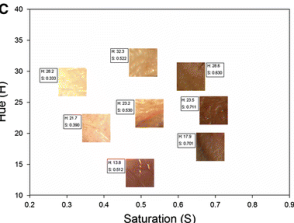Humans have been living in Europe for almost 50,000 years. During this time they’ve developed a handful of adaptations for northern climates; the most notable of which is pale skin. This appears to be to compensate for the lower light levels in northern latitudes; which would hamper the production of vitamin D from sunlight. Paler skin increases the amount of sunlight absorbed, maximising the amount of vitamin D which can be squeezed out of the light1.

The variation in skin color that results from Neanderthal genes, combined with the genes for paler skin that arose later
However, despite the fact humans have been living in Europe for so long, this appears to have been a relatively recent development; possibly within the last 15,000 years or so2. Some of the genes involved have a slightly older history, being inherited from interbreeding with the Neanderthals tens of thousands of years earlier. But these Neanderthal genes don’t code for pale skin; just influence it’s hue. Pale skin proper is actually quite a new thing; and likely took a while to fully develop even after 15,000 years ago.
In fact, new research has shown that it was still evolving as recently as the Bronze Age; a mere 6 – 4,000 years ago. For reference, that coincides with the rise of the Kingdom of Egypt, the discovery of silver and the spread of farming across Northern Europe. This investigation studied ancient DNA from this period, covering an age range of more than 2,000 years. During this time period alleles (variations) of genes associated with pale skin decreased; showing that one particular gene (i.e., the one responsible for paler skin) was being selected for over this competition. In fact, the shift in allele frequency suggests that paler skin was conveying a 10% fitness advantage over others. This might not sound a lot, but it is one of the strongest signals of selection seen in humans. The genes in question are also linked to lighter hair and eye colours3.
I’m also quite excited by this study as it’s a relatively rare example of ancient DNA of “average” people being examined. Previously analysing the DNA of long dead people was something reserved for the more extreme cases; like Neanderthals and other extinct species, or unusually old skeletons. More typical populations aren’t examined quite so often. In fact, whilst with have ancient DNA from almost half a dozen non-human hominins nobody as recovered DNA from regular old modern humans living during that time period. Who knows what we might find: a Neanderthal/human hybrid? This research shows that even more “mundane” populations can still yield fascinating genetic results and hopefully marks the start of a more in-depth analysis of our genetic history.
Apologies for the short post, I’m busy with labwork at the moment. You might have to deal with them for the next fortnight or so, but I hope you still liked it!
References
- Jablonski, N. G. (2004). The evolution of human skin and skin color. Annual Review of Anthropology, 585-623.
- Beleza, S., Santos, A. M., McEvoy, B., Alves, I., Martinho, C., Cameron, E., … & Rocha, J. (2013). The timing of pigmentation lightening in Europeans.Molecular biology and evolution, 30(1), 24-35.
- Wilde, S., Timpson, A., Kirsanow, K., Kaiser, E., Kayser, M., Unterländer, M., … & Burger, J. (2014). Direct evidence for positive selection of skin, hair, and eye pigmentation in Europeans during the last 5,000 y. Proceedings of the National Academy of Sciences, 111(13), 4832-4837

